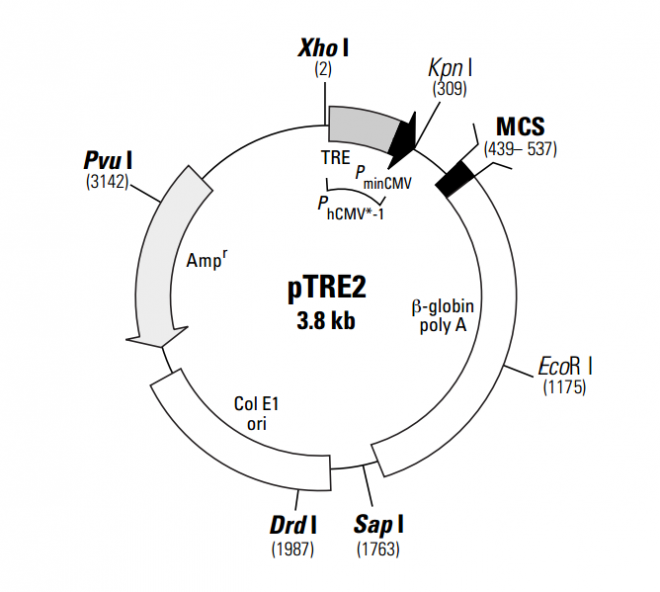pTRE2 载体
| 质粒类型: | 四环素调控系统 |
|---|---|
| 启动子: | Tet-responsive |
| 克隆方法: | 多克隆位点,限制性内切酶 |
| 载体大小: | 3757 bp (查看载体序列) |
| 载体抗性: | Ampicillin (氨苄青霉素) |
pTRE2 is a response plasmid that can be used to express a gene of interest (Gene X) in Clontech's Tet-OnTM, Tet-OffTM, RevTet-OnTM, and RevTet-OffTM Gene Expression Systems and Cell Lines (1). The Tet Expression Systems and Cell Lines give researchers ready access to the tetracycline-regulated expression systems described by Gossen & Bujard (2; Tet-Off) and Gossen et al. (3; Tet-On). pTRE2 contains an MCS immediately downstream of the Tet-responsive PhCMV*-1 promoter. cDNAs or genes inserted into the MCS will be responsive to the tTA and rtTA regulatory proteins in the Tet-Off and Tet-On systems, respectively. PhCMV*-1 contains the Tet response element (TRE), which consists of seven copies of the 42-bp tet operator sequence (tetO). The TRE is just upstream of the minimal CMV promoter (Pmin CMV), which lacks the enhancer that is part of the complete CMV promoter. Consequently, PhCMV*-1 is silent in the absence of binding of TetR or rTetR to the tetO sequences. Note that the cloned insert must have an initiating ATG codon. In some cases, addition of a Kozak consensus ribosome binding site (4) may improve expression levels; however, many cDNAs have been efficiently expressed in Tet systems without the addition of a Kozak sequence. pTRE2-Gene X plasmids should be cotransfected with the pTK-Hyg Vector (not included) to permit selection of stable transfectants.pTRE2 was originally described as pUHD10-3 in reference 5.
The pTRE2-Luc Control Vector, packaged with the pTRE2 Vector, contains an additional 1649 bp encoding firefly luciferase inserted into the MCS. This vector can be used as a reporter of induction efficiency using standard luciferase detection reagents. It is not intended as a cloning vector.


